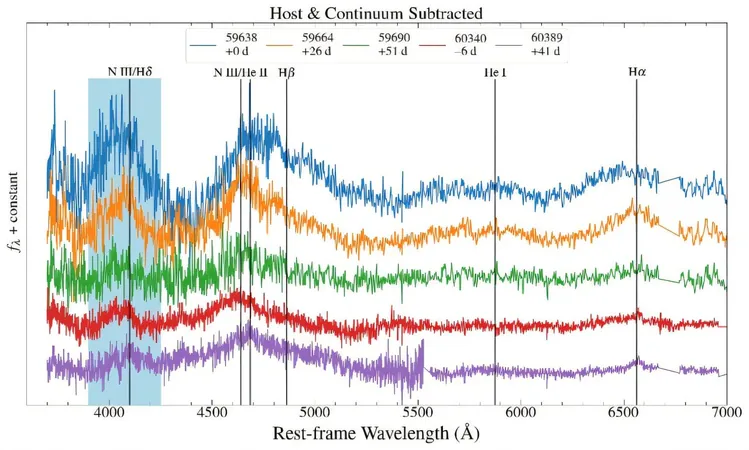
Astronomers Unveil the Mystery of a Star's Repeated Grievous Encounters with a Black Hole!
2024-11-11
Author: Wei Ling
Introduction
In an exciting astronomical discovery, scientists from the University of Science and Technology of China (USTC) have confirmed an extraordinary event involving a star that has been caught in a damaging gravitational embrace with a supermassive black hole (SMBH). This star, which orbits the SMBH in a close, elliptical path, experiences a phenomenon known as a partial tidal disruption event (pTDE) every time it approaches the pericenter of its orbit. Each encounter emits brilliant flares of light, marking one of the most dramatic cosmic events known to science.
Significant Discovery
The researchers recently identified a significant outburst linked to the TDE known as AT 2022dbl, indicating that this particular star has suffered multiple tidal disruptions. It marks the first time that a pTDE has been confirmed through spectroscopy to repeat, a breakthrough that adds a new layer of understanding to the complex dynamics between stars and black holes. Their exciting findings were published in *The Astrophysical Journal Letters*.
Mechanism of Tidal Disruptions
When a star nears a black hole, the intense gravitational forces can partially tear it apart, resulting in massive electromagnetic flares, which can reach peak brightness within weeks before gradually dimming over months or even years. Although a few candidates for repeating TDEs have been observed to rebrighten years after their original flashes, solid proof tying these events to a single star has been difficult to establish. The challenge lies in distinguishing whether the luminous flares are indeed the result of one troubled star or due to separate, independent disruptions.
Research Methodology
To tackle this, the USTC team carried out detailed observational campaigns of previously recorded TDEs, chronicling their light curves meticulously. In January 2024, they spotted the rebrightening of AT 2022dbl and swiftly initiated a comprehensive array of observations, utilizing the Swift satellite and the Las Cumbres Observatory (LCO) for detailed multi-wavelength photometric monitoring.
Spectroscopic Analysis
The researchers also obtained high-quality early spectral data using the Hale telescope at Palomar Observatory, ultimately confirming that the rebrightening was attributable to the same TDE event. Remarkably, the spectrum revealed emission lines showcasing elements produced through nuclear synthesis in the star's core, which bore striking similarities to those observed in the initial flare of AT 2022dbl.
Implications of Findings
The research team opined that this 'unlucky' star may have been torn from a stellar binary companion, becoming ensnared in a highly eccentric elliptical orbit around the black hole, subjected to repeated tidal disruptions each time it ventures close to its dark cosmic predator.
Future Research Directions
This groundbreaking research suggests that repeating pTDEs might be more common than previously believed, indicating that several established TDEs could actually be instances of this recurring phenomenon, often overlooked in traditional observations. The implications of this study could dramatically reshape our understanding of the statistical behavior and physical processes associated with optical TDEs.
Conclusion
Furthermore, this study emphasizes the critical need for continuous, high-frequency multiband monitoring of TDEs. It’s notable that TDEs are slated as a primary research focus for the Wide Field Survey Telescope (WFST), a collaborative endeavor by USTC and the Purple Mountain Observatory. With such cutting-edge tools at their disposal, researchers are optimistic about unearthing even more astounding events like AT 2022dbl, promising a surge in our knowledge of these cosmic spectacles.
Looking Ahead
What other secrets lie in the depths of our universe? Stay tuned for updates as the study of these celestial phenomena continues to offer breathtaking discoveries!



 Brasil (PT)
Brasil (PT)
 Canada (EN)
Canada (EN)
 Chile (ES)
Chile (ES)
 España (ES)
España (ES)
 France (FR)
France (FR)
 Hong Kong (EN)
Hong Kong (EN)
 Italia (IT)
Italia (IT)
 日本 (JA)
日本 (JA)
 Magyarország (HU)
Magyarország (HU)
 Norge (NO)
Norge (NO)
 Polska (PL)
Polska (PL)
 Schweiz (DE)
Schweiz (DE)
 Singapore (EN)
Singapore (EN)
 Sverige (SV)
Sverige (SV)
 Suomi (FI)
Suomi (FI)
 Türkiye (TR)
Türkiye (TR)